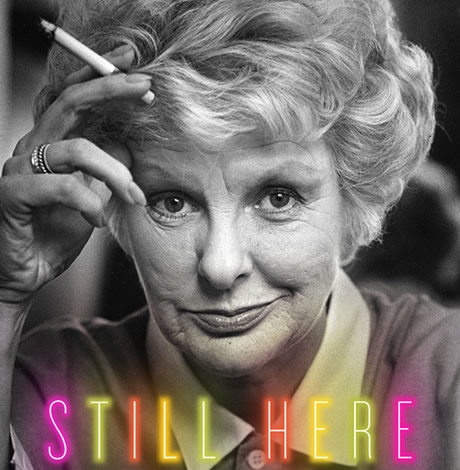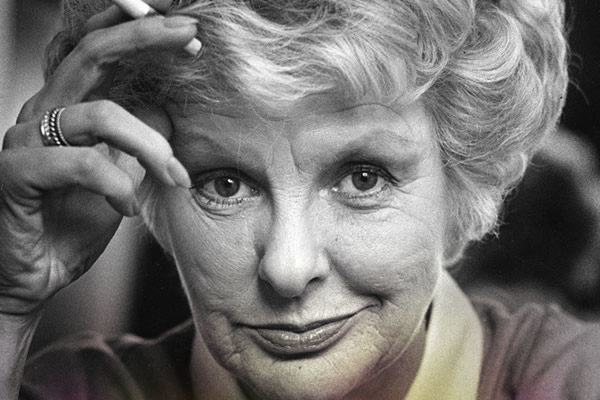Books
Late Broadway legend Elaine Stritch celebrated in new bio
‘Still Here’ rife with funny, frank tales of gay icon


‘Still Here: The Madcap, Nervy, Singular Life of Elaine Stritch’
By Alexandra Jacobs
Farrar, Straus and Giroux
$28
352 pages
Fuck! This is a fab read!
Don’t be put off! Long before everyone used the profanity, Elaine Stritch, the queer icon, actress and singer, known as “Broadway’s enduring dame,” embraced the f-word. With her gender-bending white men’s shirts and black tights, it was part of her inimitable style.
Everyone from Noel Coward to Elton John adored Stritch, who died at age 89 in 2014. She won a Tony Award for her 2001 one-woman show “Elaine Stritch At Liberty” and an Emmy for her work on “Law and Order.” Her iconic interpretation of Stephen Sondheim’s song “The Ladies Who Lunch” in the 1970 musical “Company” earned her lasting acclaim. Stritch aficionados loved it when she appeared as the mother of Jack Donaghy (Alec Baldwin) on NBC’s “30 Rock.”
Yet, she had a drinking problem and could be difficult to work with. Many, including Harold Prince, thought Stritch was an “employment risk” and a “pain in the ass.”
“How do you solve a problem like Elaine Stritch?” Nathan Lane asked at her memorial service. “How do you hold a fucking moonbeam in your hand?”
Fasten your seatbelts! “Still Here,” a new bio by Alexandra Jacobs, will take you on a fast-moving ride through Stritch’s glamorous, funny, sad, fascinating, lonely life. Along the way, you’ll encounter celebs from Marlon Brando to Rock Hudson to Bea Arthur.
Stritch was born to an upper-middle-class Catholic family in Detroit.
“The Stritches were committed but not strict Catholics,” Jacobs writes.
Yet, her family “put the convent in conventional.”
Stritch went to a convent school and Cardinal Samuel Stritch was her cousin. Years later, the columnist Earl Wilson erroneously reported that Stritch was the Cardinal’s daughter.
One day, “she went to meet the holy man in person,” Jacobs writes. “Ushered in by a nun, she sat down on a red-backed seat with a stool under it. ‘Elaine, that’s my chair,’ he told her.”
From childhood on, Stritch wanted to be in show business. At age 5, she fell in love with Fred Astaire and Ginger Rogers when an uncle took her to see “The Band Wagon” in New York.
As a child playing on the porch one day, “Elaine fatally swatted enough flies to spell out her name,” Jacobs writes. “‘It was her way of supposing her name in lights,’ according to her friend Julie Keyes. ‘And that’s what billing is about,’ Elaine told her.”
When she was 18, Stritch left the convent school and suburban Detroit behind to make it in the theater in New York. Moving there in 1943 “as a young woman in pursuit of fun, music, nightclubs and theater with all the trimmings was fantastically auspicious,” Jacobs writes.
In the middle of World War II, It was the year when “Oklahoma!” (the “Hamilton” of its time) opened on Broadway and the first American Fashion Week was held. Elaine’s impatient personality was a perfect match, Jacobs writes, for the atmosphere of New York, which was “one of urgency and carpe diem in the face of an uncertain future.”
Some of the best writing in “Still Here” is Jacobs’ evocation of this period. Stritch is so excited when she goes to try-out for the road company of “Oklahoma!” that she forgets to put her skirt on. She goes on a date with Marlon Brando, one of her classmates in the Dramatic Workshop at the New School. They had a wild night: he read to her from “Wuthering Heights.”
Stritch dated many men from producer Jed Harris to actors Gig Young and Ben Gazzara. She had a crush on Rock Hudson. Later in life, she married actor John Bay.
Because of her “low voice; her style of dress and hair, which increasingly tended toward the masculine; her delay of marriage; her many gay friends,” Jacobs writes, people have wondered if Stritch was queer.
Though gender-bending in her style, Stritch wasn’t a lesbian, Jacobs says. Yet, she writes, Stritch was “without prejudice” toward homosexuality. “Live and let live,” Stritch would say.
“Look into their eyes/And you’ll see what they know/Everybody dies,” Stritch sang in “The Ladies Who Lunch.”
Reading “Still Here” will make you feel as if Stritch, brought back to life, is looking into your eyes and singing just for you.
Books
Two new books on dining out LGBTQ-style
Visit nightclubs, hamburger joints, and a bathhouse that feeds customers

‘What is Queer Food? How We Served a Revolution’
By John Birdsall
c.2025, W.W. Norton
$29.99/304 pages
‘Dining Out: First Dates, Defiant Nights, and Last Call Disco Fries at America’s Gay Restaurants’
By Erik Piepenburg
c.2025, Grand Central
$30/352 pages
You thought a long time about who sits where.
Compatibility is key for a good dinner party, so place cards were the first consideration; you have at least one left-hander on your guest list, and you figured his comfort into your seating chart. You want the conversation to flow, which is music to your ears. And you did a good job but, as you’ll see with these two great books on dining LGBTQ-style, it’s sometimes not who sits where, but whose recipes were used.
When you first pick up “What is Queer Food?” by John Birdsall, you might miss the subtitle: “How We Served a Revolution.” It’s that second part that’s important.

Starting with a basic gay and lesbian history of America, Birdsall shows how influential and (in)famous 20th century queer folk set aside the cruelty and discrimination they received, in order to live their lives. They couldn’t speak about those things, he says, but they “sat down together” and they ate.
That suggested “a queer common purpose,” says Birdsall. “This is how who we are, dahling, This is how we feed our own. This is how we stay alive.”
Readers who love to cook, bake or entertain, collect cookbooks, or use a fork will want this book. Its stories are nicely served, they’re addicting, and they may send you in search of cookbooks you didn’t know existed.
Sometimes, though, you don’t want to be stuck in the kitchen, you want someone else to bring the grub. “Dining Out” by Erik Piepenburg is an often-nostalgic, lively look at LGBTQ-friendly places to grab a meal – both now and in the past.

In his introduction, Piepenburg admits that he’s a journalist, “not a historian or an academic,” which colors this book, but not negatively. Indeed, his journeys to “gay restaurants” – even his generous and wide-ranging definitions of the term – happily influence how he presents his narrative about eateries and other establishments that have fed protesters, nourished budding romances, and offered audacious inclusion.
Here, there are modern tales of drag lunches and lesbian-friendly automats that offered “cheap food” nearly a century ago. You’ll visit nightclubs, hamburger joints, and a bathhouse that feeds customers on holidays. Stepping back, you’ll read about AIDS activism at gay-friendly establishments, and mostly gay neighborhood watering holes. Go underground at a basement bar; keep tripping and meet proprietors, managers, customers and performers. Then take a peek into the future, as Piepenburg sees it.
The locales profiled in “Dining Out” may surprise you because of where they can be found; some of the hot-spots practically beg for a road trip.
After reading this book, you’ll feel welcome at any of them.
If these books don’t shed enough light on queer food, then head to your favorite bookstore or library and ask for help finding more. The booksellers and librarians there will put cookbooks and history books directly in your hands, and they’ll help you find more on the history and culture of the food you eat. Grab them and you’ll agree, they’re pretty tasty reads.
The Blade may receive commissions from qualifying purchases made via this post.

You’re going to be on your feet a lot this month.
Marching in parades, dancing in the streets, standing up for people in your community. But you’re also likely to have some time to rest and reflect – and with these great new books, to read.
First, dip into a biography with “Marsha: The Joy and Defiance of Marsha P. Johnson” by Tourmaline (Tiny Rep Books, $30), a nice look at an icon who, rumor has it, threw the brick that started a revolution. It’s a lively tale about Marsha P. Johnson, her life, her activism before Stonewall and afterward. Reading this interesting and highly researched history is a great way to spend some time during Pride month.
For the reader who can’t live without music, try “The Dad Rock That Made Me a Woman” by Niko Stratis (University of Texas Press, $27.95), the story of being trans, searching for your place in the world, and finding it in a certain comfortable genre of music. Also look for “The Lonely Veteran’s Guide to Companionship” by Bronson Lemer (University of Wisconsin Press, $19.95), a collection of essays that make up a memoir of this and that, of being queer, basic training, teaching overseas, influential books, and life.
If you still have room for one more memoir, try “Walk Like a Girl” by Prabal Gurung (Viking, $32.00). It’s the story of one queer boy’s childhood in India and Nepal, and the intolerance he experienced as a child, which caused him to dream of New York and the life he imagined there. As you can imagine, dreams and reality collided but nonetheless, Gurung stayed, persevered, and eventually became an award-winning fashion designer, highly sought by fashion icons and lovers of haute couture. This is an inspiring tale that you shouldn’t miss.
No Pride celebration is complete without a history book or two.
In “Trans History: From Ancient Times to the Present Day” by Alex L. Combs & Andrew Eakett ($24.99, Candlewick Press), you’ll see that being trans is something that’s as old as humanity. One nice part about this book: it’s in graphic novel form, so it’s lighter to read but still informative. Lastly, try “So Many Stars: An Oral History of Trans, Nonbinary, Genderqueer, and Two-Spirit People of Color” by Caro De Robertis (Algonquin Books of Chapel Hill. $32.00) a collection of thoughts, observations, and truths from over a dozen people who share their stories. As an “oral history,” you’ll be glad to know that each page is full of mini-segments you can dip into anywhere, read from cover to cover, double-back and read again. It’s that kind of book.
And if these six books aren’t enough, if they don’t quite fit what you crave now, be sure to ask your favorite bookseller or librarian for help. There are literally tens of thousands of books that are perfect for Pride month and beyond. They’ll be able to determine what you’re looking for, and they’ll put it directly in your hands. So stand up. March. And then sit and read.
a&e features
James Baldwin bio shows how much of his life is revealed in his work
‘A Love Story’ is first major book on acclaimed author’s life in 30 years

‘Baldwin: A Love Story’
By Nicholas Boggs
c.2025, FSG
$35/704 pages
“Baldwin: A Love Story” is a sympathetic biography, the first major one in 30 years, of acclaimed Black gay writer James Baldwin. Drawing on Baldwin’s fiction, essays, and letters, Nicolas Boggs, a white writer who rediscovered and co-edited a new edition of a long-lost Baldwin book, explores Baldwin’s life and work through focusing on his lovers, mentors, and inspirations.
The book begins with a quick look at Baldwin’s childhood in Harlem, and his difficult relationship with his religious, angry stepfather. Baldwin’s experience with Orilla Miller, a white teacher who encouraged the boy’s writing and took him to plays and movies, even against his father’s wishes, helped shape his life and tempered his feelings toward white people. When Baldwin later joined a church and became a child preacher, though, he felt conflicted between academic success and religious demands, even denouncing Miller at one point. In a fascinating late essay, Baldwin also described his teenage sexual relationship with a mobster, who showed him off in public.
Baldwin’s romantic life was complicated, as he preferred men who were not outwardly gay. Indeed, many would marry women and have children while also involved with Baldwin. Still, they would often remain friends and enabled Baldwin’s work. Lucien Happersberger, who met Baldwin while both were living in Paris, sent him to a Swiss village, where he wrote his first novel, “Go Tell It on the Mountain,” as well as an essay, “Stranger in the Village,” about the oddness of being the first Black person many villagers had ever seen. Baldwin met Turkish actor Engin Cezzar in New York at the Actors’ Studio; Baldwin later spent time in Istanbul with Cezzar and his wife, finishing “Another Country” and directing a controversial play about Turkish prisoners that depicted sexuality and gender.
Baldwin collaborated with French artist Yoran Cazac on a children’s book, which later vanished. Boggs writes of his excitement about coming across this book while a student at Yale and how he later interviewed Cazac and his wife while also republishing the book. Baldwin also had many tumultuous sexual relationships with young men whom he tried to mentor and shape, most of which led to drama and despair.
The book carefully examines Baldwin’s development as a writer. “Go Tell It on the Mountain” draws heavily on his early life, giving subtle signs of the main character John’s sexuality, while “Giovanni’s Room” bravely and openly shows a homosexual relationship, highly controversial at the time. “If Beale Street Could Talk” features a woman as its main character and narrator, the first time Baldwin wrote fully through a woman’s perspective. His essays feel deeply personal, even if they do not reveal everything; Lucian is the unnamed visiting friend in one who the police briefly detained along with Baldwin. He found New York too distracting to write, spending his time there with friends and family or on business. He was close friends with modernist painter Beauford Delaney, also gay, who helped Baldwin see that a Black man could thrive as an artist. Delaney would later move to France, staying near Baldwin’s home.
An epilogue has Boggs writing about encountering Baldwin’s work as one of the few white students in a majority-Black school. It helpfully reminds us that Baldwin connects to all who feel different, no matter their race, sexuality, gender, or class. A well-written, easy-flowing biography, with many excerpts from Baldwin’s writing, it shows how much of his life is revealed in his work. Let’s hope it encourages reading the work, either again or for the first time.
-

 Hungary4 days ago
Hungary4 days agoUpwards of 100K people march in Budapest Pride
-

 U.S. Supreme Court10 hours ago
U.S. Supreme Court10 hours agoSupreme Court to consider bans on trans athletes in school sports
-

 Out & About12 hours ago
Out & About12 hours agoCelebrate the Fourth of July the gay way!
-

 Opinions3 days ago
Opinions3 days agoSupreme Court decision on opt outs for LGBTQ books in classrooms will likely accelerate censorship











